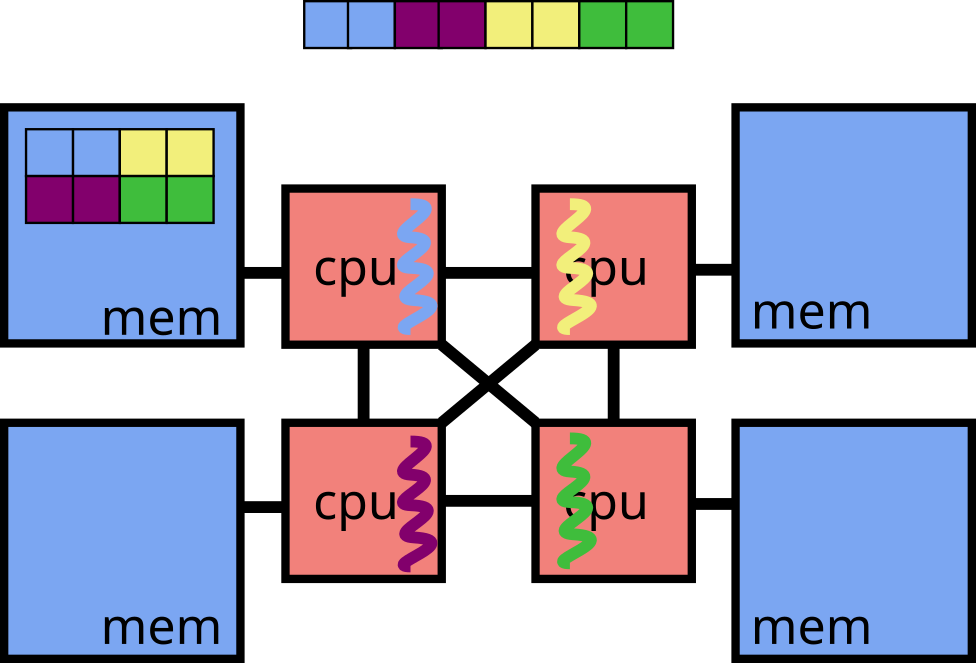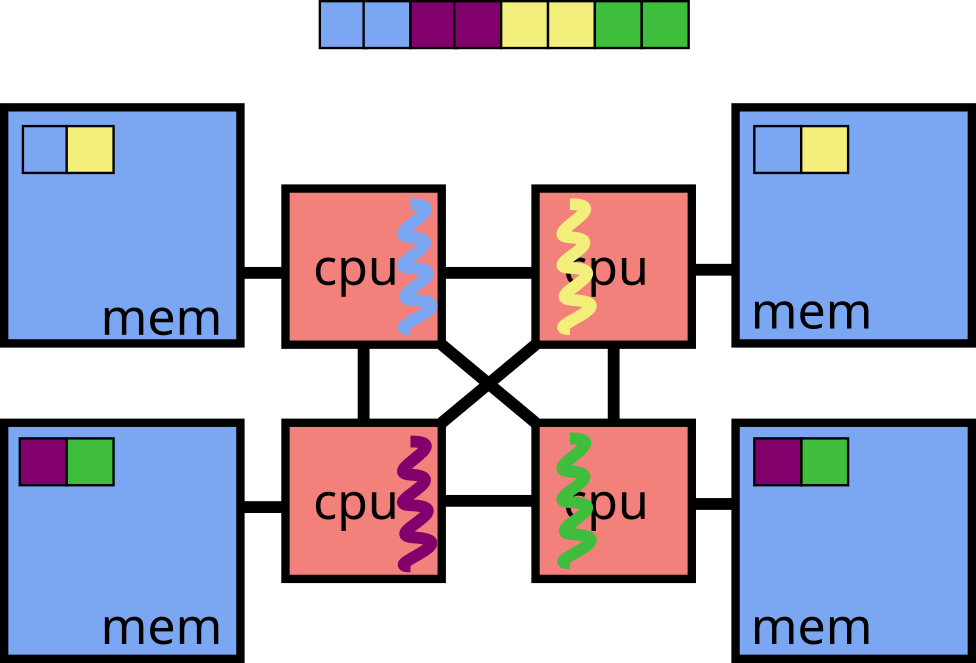Virtual memory
François Trahay
Introduction
A process needs to be present in main memory to run
Central memory divided into two parts
- The space reserved for the operating system
- The space allocated to processes
Memory management concerns the process space
Memory capacities are increasing, but so are the requirements → Need for multiple memory levels
- Fast memory (cache)
- Central memory (RAM)
- Auxiliary memory (disk)
Principle of inclusion to limit updates between different levels
Paging
Overview

- The address space of each program is split into pages
- Physical memory divided into page frames
- Matching between some pages and page frames
Status of memory pages
The memory pages of a process can be
- In main memory / in RAM (active pages)
- Non-existent in memory (inactive pages never written)
- In secondary memory / in the Swap (inactive pages that have already been written)
→ each process has a contiguous memory space to store its data
The paging mecanism
- Translates virtual addresses to/from physical addresses
- Loads the necessary pages (in case of page faults)
- (Optionally) move active pages to secondary memory
Logical (or virtual) address
- Address space is divided using the most significant bits
- Logical address on
kbits:- Page number:
pbits - Offset in the page:
d = (k - p)bits
- Page number:
- Logical address on
- Page size
- Usually 4 KiB (k-p = 12 bits, so p = 52 bits)
- Huge pages: 2 MiB, 1 GiB, 512 GiB, or 256 TiB pages
- Choice = compromise between various opposing criteria
- Last page is half wasted
- Small capacity memory : small pages
- Scalability of the page management system
Page table
The correspondence between logical address and address physical is done with a page table that contains
- Page frame number
- Information bits (presence, permissions, upload timestamp …)
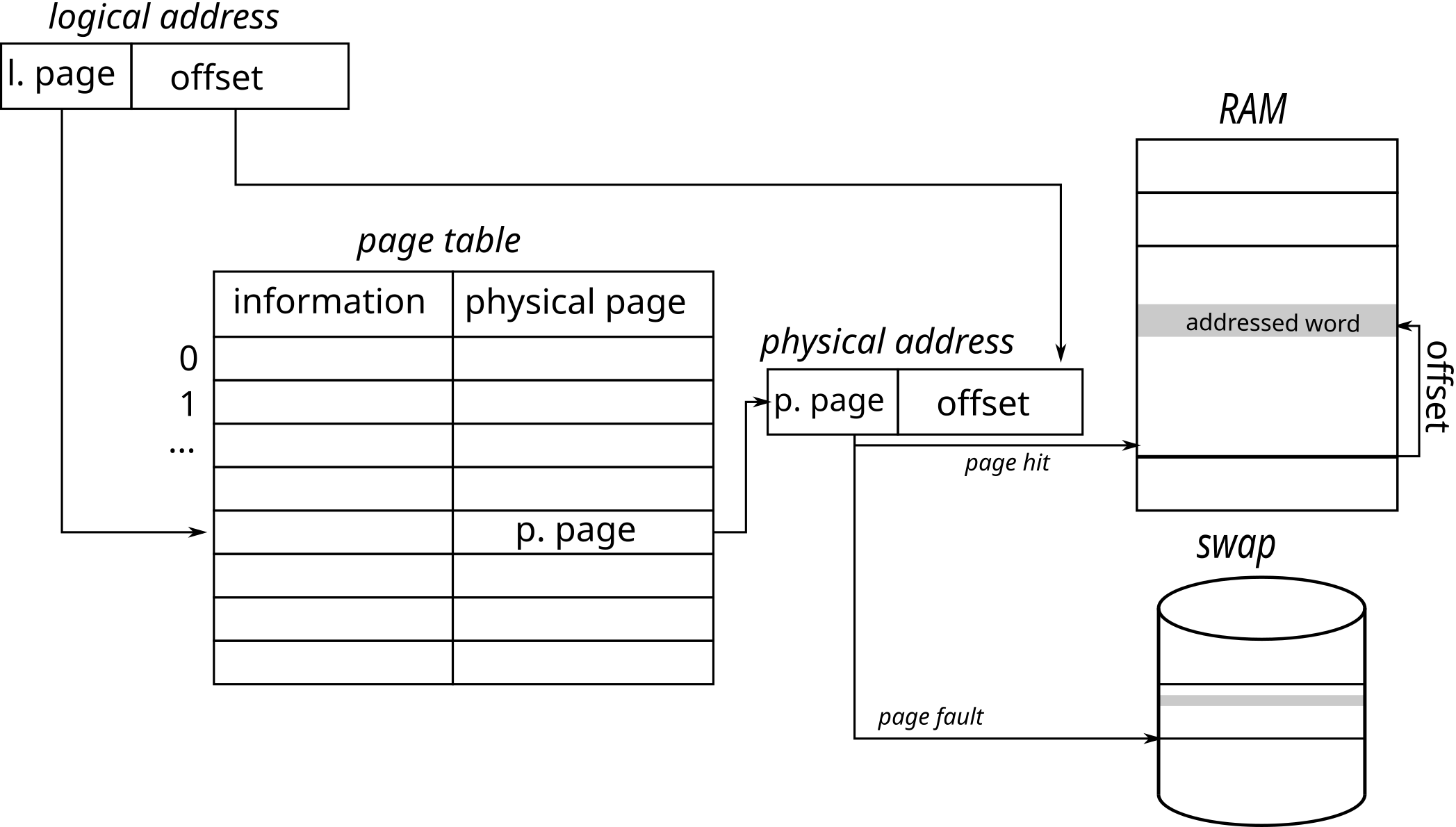
Implementation of a page table
- On
x86_64orRISC-V, a page table = 4-levels tree- The physical address of a 512-entry root table is stored in the
satpregister (cr3onx86architectures) - Each entry in a table gives the address of the following table
- virtual address decomposed into 4 indexes (
n[0..3]) + 1 offset, then translated using:
- The physical address of a 512-entry root table is stored in the
uint64_t cur = %satp3; // cur = root table physical address
for(int i=0; i<3; i++)
cur = ((uint64_t*)cur)[n[i]]; // physical memory access, next entry
return cur + offset; // add the offset
Translation Lookaside Buffer (TLB)
- Problem: any access to information requires several memory accesses
- Solution: use associative memories (fast access registers)
- Principle
- A number of registers are available
- Logical page number Np compared to the content of each register
- if found → gives the corresponding frame number Nc
- Otherwise use the page table
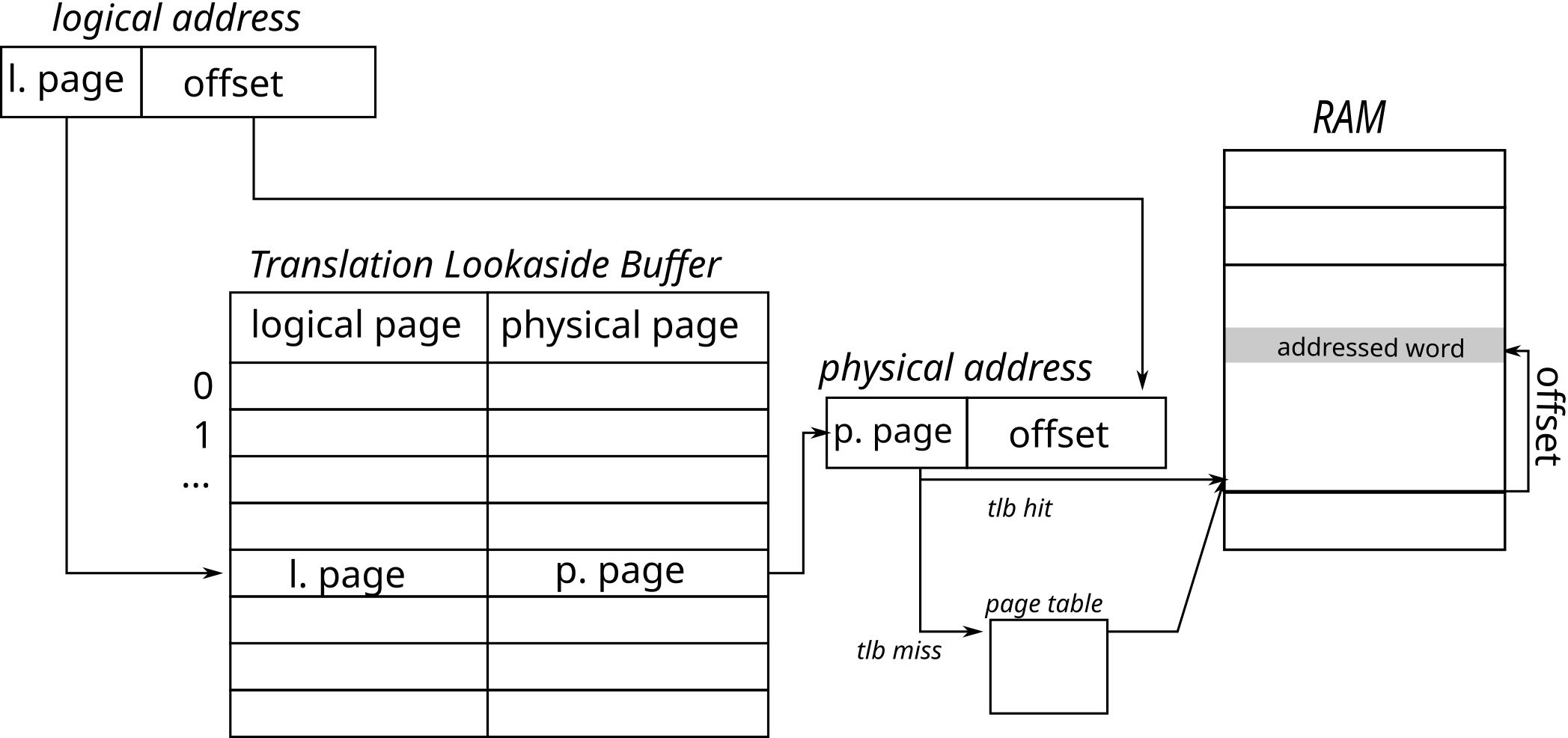
User point of view
Memory space of a process
- Composed of:
- kernel space
- the different sections of the executed ELF file (
.text,.data, etc.) - the heap
- the stack (one per thread)
- shared libraries
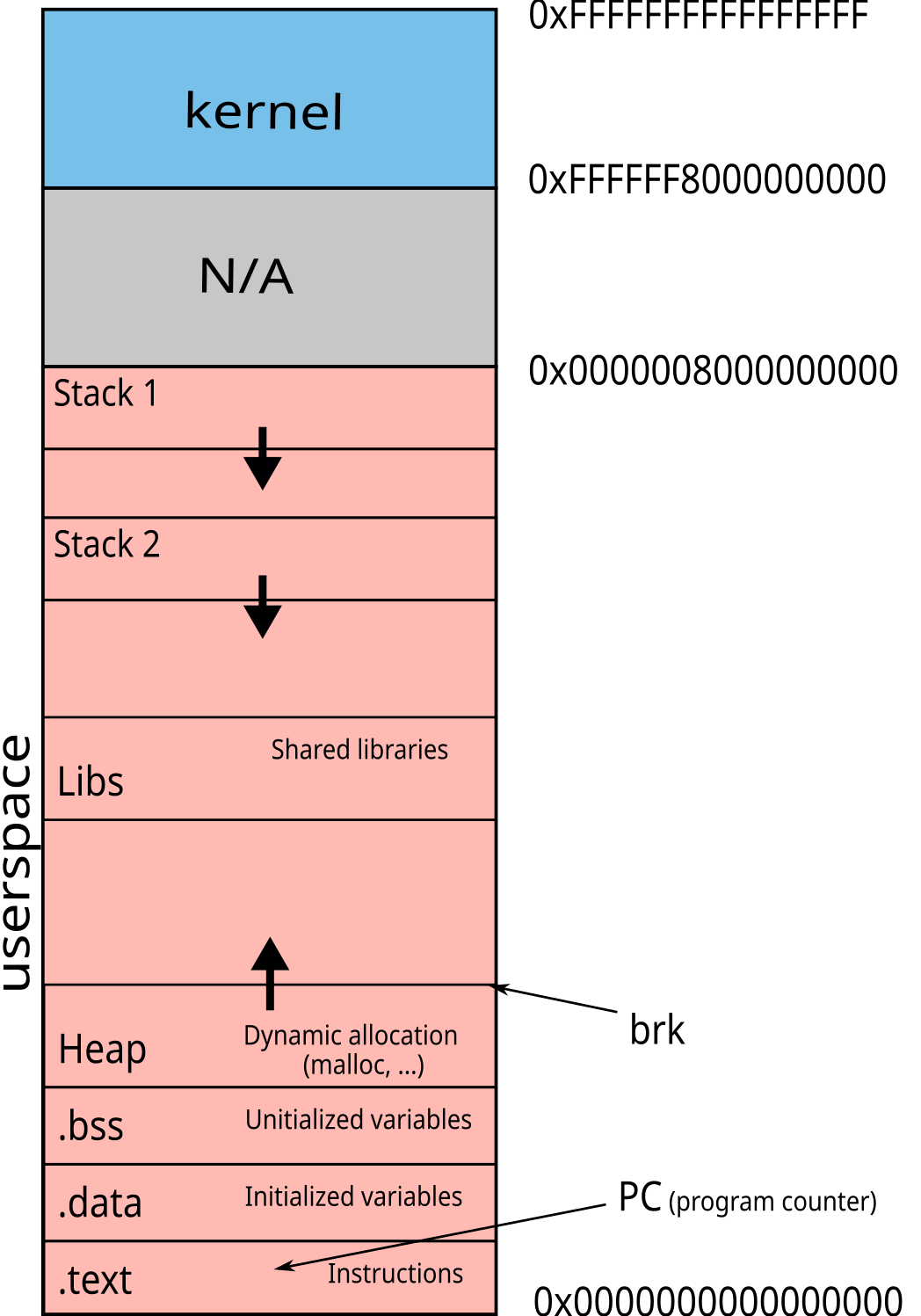
Memory mapping
- How to populate the memory space of a process?
- For each ELF file to be loaded:
- open the file with
open - each ELF section is mapped in memory (with
mmap) with the appropriate permissions - Results are visible in
/proc/<pid>/maps
- open the file with
- For each ELF file to be loaded:
$ cat /proc/self/maps
5572f3023000-5572f3025000 r--p 00000000 08:01 21495815 /bin/cat
5572f3025000-5572f302a000 r-xp 00002000 08:01 21495815 /bin/cat
5572f302e000-5572f302f000 rw-p 0000a000 08:01 21495815 /bin/cat
5572f4266000-5572f4287000 rw-p 00000000 00:00 0 [heap]
7f33305b4000-7f3330899000 r--p 00000000 08:01 22283564 /usr/lib/locale/locale-archive
7f3330899000-7f33308bb000 r--p 00000000 08:01 29885233 /lib/x86_64-linux-gnu/libc-2.28.so
7f33308bb000-7f3330a03000 r-xp 00022000 08:01 29885233 /lib/x86_64-linux-gnu/libc-2.28.so
[...]
7f3330ab9000-7f3330aba000 rw-p 00000000 00:00 0
7ffe4190f000-7ffe41930000 rw-p 00000000 00:00 0 [stack]
7ffe419ca000-7ffe419cd000 r--p 00000000 00:00 0 [vvar]
7ffe419cd000-7ffe419cf000 r-xp 00000000 00:00 0 [vdso]Memory allocation
void* malloc(size_t size)- Returns a pointer to an buffer of
size bytes
- Returns a pointer to an buffer of
void* realloc(void* ptr, size_t size)- Changes the size of a buffer previously allocated by
malloc
- Changes the size of a buffer previously allocated by
void* calloc(size_t nmemb, size_t size)- Same as
malloc, but memory is initialized to 0
- Same as
void *aligned_alloc( size_t alignment, size_t size )- Same as
malloc. The returned address is a multiple ofalignment
- Same as
void free(void* ptr)- Free an allocated buffer
Memory alignment
Memory alignment depends on the type of data
char(1-byte),short(2-bytes),int(4-bytes), …
A data structure may be larger than its content
![]()
A data structure can be packed with
__attribute__((packed))![]()
The libc point of view
- How to request memory from the OS
void *sbrk(intptr_t increment)- increase the heap size by
incrementbytes
- increase the heap size by
void *mmap(void *addr, size_t length, int prot, int flags, int fd, off_t offset)- map a file in memory
- if
flagscontainsMAP_ANON, does not map any file, but allocates an area filled with 0s
Memory allocation strategies
Non-Uniform Memory Access
- Several interconnected memory controllers
- Memory consistency between processors
- Privileged access to the local memory bank
- Possible access (with an additional cost) to distant memory banks
→ Non-Uniform Memory Access → On which memory bank to allocate data?
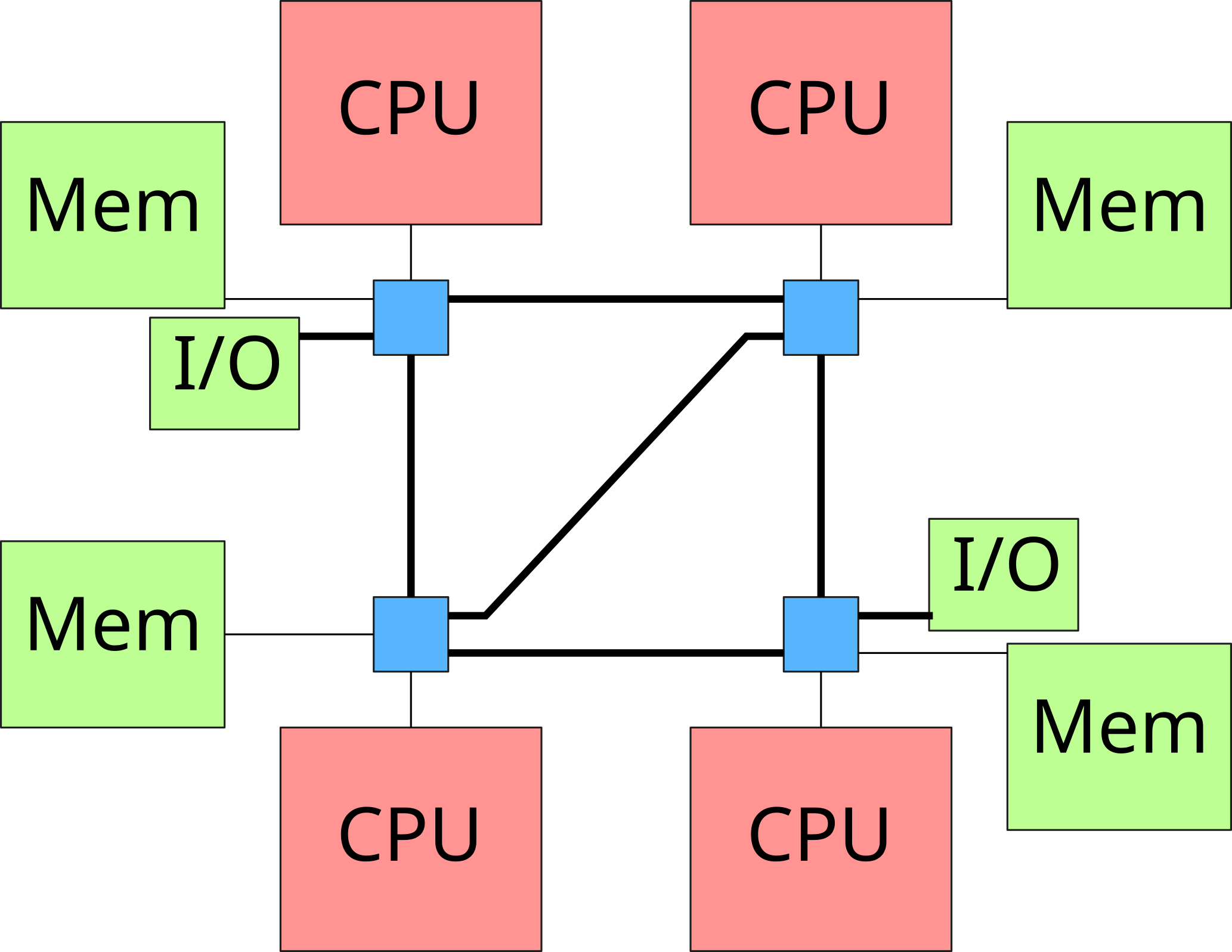
First touch allocation strategy
- Linux default lazy allocation strategy
- Allocation of a memory page on the local node when first accessed
- Assumption: the first thread to use a page will probably will use it in the future
Interleaved allocation strategy
- Pages are allocated on the different nodes in a round-robin fashion
- Allows load balancing between NUMA nodes
void *numa_alloc_interleaved(size_t size)
mbind
long mbind(void *addr, unsigned long len, int mode, const unsigned long *nodemask, unsigned long maxnode, unsigned flags)- Place a set of memory pages on a (set of) NUMA node → allows manual placement of memory pages


